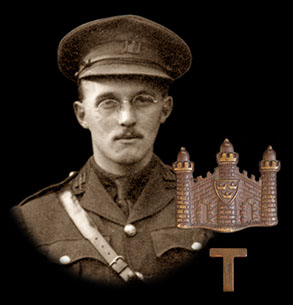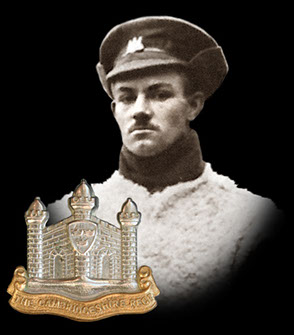
Who Were
The Cambs
The Cambs
at War
1/1st Btn 1914-1919
1914 - 1/1st Overview
1915 - 1/1st Overview
1915 - St Eloi
1915 - Fosse Wood
1916 - 1/1st Overview
1916 - The Schwaben
1916 - St Pierre Divion
1917 - 1/1st Overview
1917 - St Julien
Insignia, Medals & Books
Remembering The Cambs
Biographies
About Us &
This Site
The Final Road to the Armistice – 15th October to 11th November 1918.
As dawn broke on 16th October 1918, the weary men of the 1/1st Battalion, Cambridgeshire Regiment were recovering after their part in the fighting around Auby. After spending a day in billets around the mining village of Drocourt, the Battalion then moved up, following behind the advancing units until, on 20th October, it was their turn to lead the advance.
With the Germans now falling back at considerable speed the advance was covering a sizable distance each day. The Cambridgeshires, as advance guard for their brigade, had A and D Coys as vanguard and B and C Coys following closely behind as mainguard. Moving rapidly, following the roads, no serious opposition was met until they had passed through the village of Landas. The ground to the east of Landas was flat and open for over a mile. Situated on the eastern edge of this flat ground was the German held village of Sameon. Cavalry scouts reported the presence of a detachment of Germans in the village to the advancing Cambridgeshires who were soon coming under machine gun fire from these positions.
Choosing to not hesitate and using a heavy deluge of rifle and Lewis gun fire for cover, the men of A and D Coys were able to cover the open ground quickly, moving up in platoon rushes. Just in front of the enemy position the men of D Coy, utilising a tactic Clayton had devised, went to ground in a line with every man opening rapid fire on the enemy. Under this torrent of near point blank fire the German garrison either fled or were captured. Within seconds of the German machine guns being silenced the cavalry advanced, giving chase to any fleeing enemy and scouting the ground east of the village. The attack had been a very one-sided affair and remarkably, despite the open ground, no Cambridgeshires had been hit.
After the positions on the eastern side of the village had been cleared the Cambridgeshires pushed through the rest of the village finding no further serious opposition. Soon patrols were pushing out further east while the others formed a defensive line for the night. One patrol, on reaching the nearby village of Rumegies, engaged in a short skirmish with the enemy that resulted in the Battalion's only casualty of the day, Thomas Thacker from Coalville, Leicestershire. Thomas had been posted to the Cambridgeshires as part of a large draft of men from the Leicestershire Regiment in late August 1918, he was buried in Sameon churchyard.
The following morning the 7th Norfolks took over the role of advance guard and moved through the Cambs who were now to act as support battalion. As the front pushed on the Cambridgeshires remained in the village of Sameon for a few days. It was while in this area on 22nd October that the Battalion suffered its last man to be killed in action when Clement Strange, a battalion cook from Cambridge, was hit by shrapnel during a sporadic bombardment of the village. Alongside Clement several other men were wounded in this shelling, including several from the Leicestershire Regiment draft.
By the afternoon of the 22nd October the Battalion moved to Rosult where it remained until the 26th. While at Rosult on October 25th a tragic accident occurred that resulted in the death of Edwin Marriott from Fletton, Peterborough. Edwin, a former pupil of King Edward VII Grammar School, King’s Lynn, had originally enlisted in the Norfolk Regiment. He was posted to the Cambridgeshires in August 1916 where he served as a Lewis Gunner. Wounded three times with the Cambs, including during the bitter fighting at St Julien in 1917, he was accidentally shot in the neck by his best friend who had been cleaning his rifle beside him. Edwin was buried in Sameon churchyard, alongside Thomas Thacker and Clement Strange.
On the morning of October 26th, as the Battalion was preparing to moving back into the front line, word came through that the 12th Division was being relieved and they would be moving back for a rest. The following morning they moved west, arriving at Raches in the afternoon of 28th October, where they remained for the next week. The Battalion finally started moving east again on 9th November when they moved to St Amand les Eaux and marched to the nearby Odomez, repairing the roads that were damaged during the fighting or sabotaged by the retreating enemy. After a night in Odomez the Cambs moved north, over the Scheldt, arriving in Hergnies where the men continued to toil on seemingly endless road repairs.
Early on the morning of 11th November 1918, the news of the impending Armistice reached the men of the 1/1st Battalion, Cambridgeshire Regiment in the small French village of Hergnies on the French/Belgian border. The news came as a bit of an anticlimax after the months of frantic advances and heavy fighting, in fact the Battalion’s War Diary entry for the day does not even mention it and just simply states: Working parties under C.R.E. (Commander Royal Engineers).
Later when writing the regimental history, Lt Col Clayton, who was away from the Battalion at the time, quoted an unknown Cambs officer: We stood in silence wondering what it all meant; then we awkwardly shook hands all round and sat down to a hurried and scanty meal. We slaved all day repairing the roads, pulling down walls and collecting material to fill the holes, and I doubt whether even at the end of the day we realized the full significance of the news.
So for the Cambs, the monumental day that saw an end to fighting on the Western Front was spent carrying out the unglamorous and tiresome task of road repairs. While hostilities had now ended, ahead lay days of hard graft on working parties, endless battlefield salvage and training. For many of the men it would be months before they returned home and, for an unlucky few, the Spanish flu epidemic would rob them of their future.

Capt Herbert Corbett, killed in action 17th October while attached to the Essex Regt.

Clement Strange, the last Cambridgeshire to be killed in action in the First World War.

This site went live on the 14th February 2015 to mark 100 years since the 1/1st Cambs went off to war.
WE WILL REMEMBER THEM
Email us: cambsregt@gmail.com
Copyright 2015, 2016, 2017, 2018, 2019 by Felix Jackson. The information and images on this site should not be reproduced without prior permission.